Therapies and Interventions
Mastering 'Why' Questions: Speech Therapy Guide
Wondering how 'why' questions can transform speech therapy sessions? Dive into this guide for insightful strategies and tips.
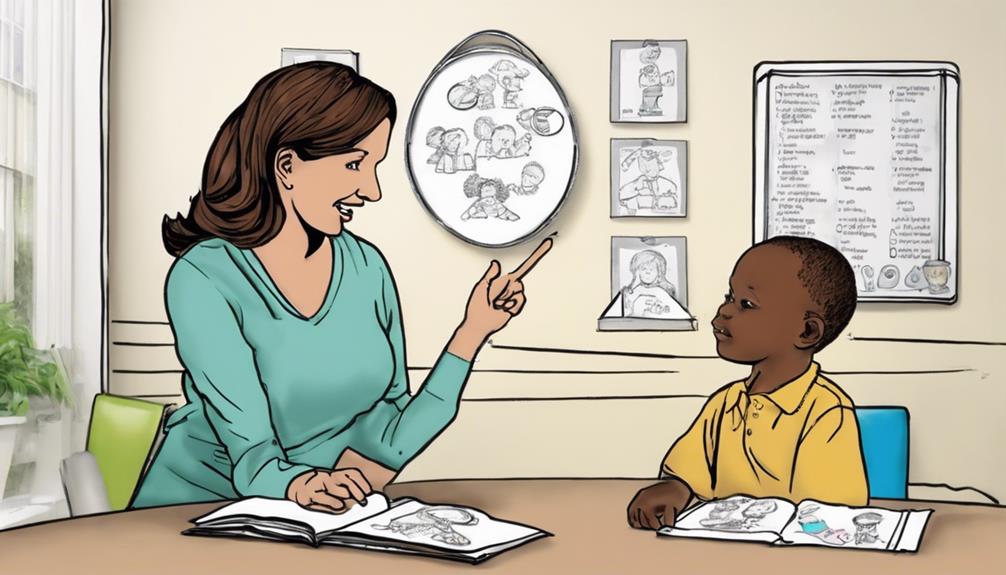
In accordance with the adage, “Wisdom begins by asking ‘why’.”
Exploring the intricacies of 'why' questions in speech therapy uncovers a world of opportunities for enhancing communication skills in children.
Understanding the nuances of 'why' questions can significantly impact language development and critical thinking abilities.
By delving into this guide, we can uncover practical strategies and insights that pave the way for improved cognitive and linguistic growth in young learners.
Key Takeaways
- 'Why' questions are essential for communication and cognitive development.
- Teaching strategies focus on question word emphasis and interactive activities.
- Different types of 'Why' questions enhance critical thinking and reasoning skills.
- Visual aids and interactive exercises improve understanding and engagement in learning 'Why' questions.
Understanding 'Why' Questions
In speech therapy, grasping the essence of 'why' questions is fundamental for unlocking deeper insights into communication challenges. 'Why' questions serve as a pathway to understanding reasons, causes, and motivations behind actions and events. By delving into the 'why' of a situation, individuals can unravel intricate cause-and-effect relationships, fostering critical thinking skills and honing their ability to analyze situations with depth and clarity.
When we explore 'why' questions, we not only encourage language development but also promote cognitive flexibility and problem-solving skills. For children, in particular, 'why' questions play a pivotal role in nurturing curiosity, encouraging them to engage in deeper conversations, and enhancing their overall communication proficiency. Through practicing 'why' questions in speech therapy sessions, individuals can't only improve their ability to express themselves effectively but also gain valuable insights into emotional regulation and navigating social interactions. Understanding 'why' questions is a cornerstone in building a strong foundation for communication and cognitive growth.
Importance of 'Why' Questions

Understanding the significance of 'Why' questions lies at the core of effective communication and cognitive development, offering invaluable insights into the underlying reasons and motivations that shape our interactions and behaviors. Answering 'why' questions is not merely about providing a response; it is a pathway to developing reasoning, critical thinking, and understanding cause-and-effect relationships. By delving into the 'whys' of situations, events, and behaviors, individuals are prompted to engage in higher-level thinking, encouraging reflection and problem-solving skills essential for academic success. Moreover, mastering 'why' questions plays a pivotal role in language development, fostering communication skills and expressive abilities, particularly in children. This proficiency in addressing 'why' inquiries not only supports overall language proficiency but also enhances social interactions, making it a fundamental aspect of speech therapy. The table below encapsulates the importance of 'why' questions in various aspects of cognitive and linguistic development:
| Benefits of 'Why' Questions | ||
|---|---|---|
| Develop reasoning | Critical thinking | Language development |
| Communication skills | Higher-level thinking |
Teaching 'Why' Questions
Let's emphasize the importance of using question words effectively to teach 'why' questions in speech therapy.
By providing practical examples during sessions, children can grasp the concept and apply it confidently.
Engaging in interactive learning activities can make the experience enjoyable and beneficial for students learning to ask and answer 'why' questions.
Question Word Importance
Exploring the significance of teaching 'Why' questions is vital for nurturing children's critical thinking skills. Understanding the importance of question word usage helps children develop reasoning skills and advance their language abilities. By teaching 'Why' questions, we empower children to delve deeper into the motives and causes behind actions, fostering analytical thinking and effective expression of thoughts. This process not only enhances critical thinking but also promotes vocabulary expansion. Integrating 'Why' questions into various activities like story read-alouds and science experiments can significantly boost engagement and comprehension levels in children. Check out the table below to see the key benefits of teaching 'Why' questions:
| Key Benefits | Description |
|---|---|
| Enhances critical thinking | Promotes deeper understanding of reasons and motives behind actions |
| Fosters analytical thinking | Encourages making connections and expressing thoughts effectively |
| Supports language development | Aids in reasoning skills development and expands vocabulary |
Practical Examples Given
Engage children through interactive activities that prompt them to ask 'why' questions, fostering curiosity and critical thinking skills. Here are some practical examples for teaching 'why' questions in speech therapy:
- Story Read-Alouds: Use engaging stories to encourage children to ask 'why' questions, promoting reasoning skills.
- Picture Scenes: Utilize visual aids during therapy sessions to help children practice answering 'why' questions effectively.
- Science Experiments and Cooking Activities: Conduct hands-on activities to evoke 'why' questions, sparking curiosity and critical thinking.
- Exploring Careers: Introduce children to different professions to generate career-related 'why' questions, fostering interest and expanding their understanding.
Incorporating these activities can enhance language skills and encourage thoughtful responses in speech therapy sessions.
Interactive Learning Activities
Utilizing interactive learning activities in speech therapy sessions enhances children's ability to formulate 'why' questions, fostering critical thinking skills and language development. These activities engage children in critical thinking and reasoning skills development through picture scenes, science experiments, and cooking activities.
By exploring different careers and generating related 'Why' questions, children can better understand cause-and-effect relationships. Story read-alouds also provide valuable opportunities for asking 'Why' questions and discussing behaviors and motivations.
These interactive learning activities not only target language development but also enhance cognitive skills, catering to varying levels of complexity in answering 'Why' questions. Incorporating such activities in speech therapy sessions can significantly benefit children's overall development and understanding of 'Why' questions.
Assessing 'Why' Question Skills

Assessing children's 'Why' question skills involves delving into their ability to provide reasons or explanations for events or actions. It's a crucial aspect of Speech Therapy as it helps in understanding a child's reasoning abilities and language development.
Here are some key points to consider when assessing a child's 'Why' question skills:
- Comprehension Evaluation: Assess how well the child understands the 'Why' questions asked and whether they can grasp the underlying reasons or causes.
- Critical Thinking Assessment: Evaluate the child's critical thinking skills by analyzing the depth of their answers and the logic behind their explanations.
- Identifying Difficulty Areas: Use the assessment to pinpoint specific areas where the child may struggle in reasoning or understanding cause-and-effect relationships.
- Guiding Intervention Strategies: Results from assessing 'Why' questions can help in tailoring speech therapy interventions to target the child's individual needs effectively.
Discriminating 'Why' Questions

Understanding the reasons behind actions or events is fundamental in discriminating 'Why' questions. When working on discriminating 'Why' questions, it's crucial to focus on the child's ability to answer by delving into the understanding of reasons.
By exploring cause-and-effect relationships, children can develop critical thinking and logical reasoning skills. This process not only aids in answering 'Why' questions effectively but also enhances their overall communication skills.
Discriminating 'Why' questions allows children to differentiate between different motivations or explanations, which is essential for effective communication in various contexts. By honing these skills, children can grasp the underlying reasons behind behaviors or occurrences, paving the way for clearer and more concise responses.
Encouraging the development of logical reasoning in response to 'Why' questions can significantly contribute to the child's ability to express themselves cohesively and comprehend the world around them better.
Examples of 'Why' Questions

As we explore 'Examples of 'Why' Questions', understanding the different types of 'Why' questions, recognizing the importance of 'Why' in child development, and learning effective strategies for asking 'Why' questions are key points to consider.
By grasping these elements, we can guide children towards critical thinking skills and enhance their ability to comprehend cause and effect relationships.
Engaging in activities that encourage questioning can spark curiosity and foster a deeper understanding of the world around us.
Types of 'Why' Questions
In exploring the different types of 'Why' questions, we delve into the motivations and underlying reasons behind actions and decisions.
- Causal 'Why' Questions: These focus on determining the cause-and-effect relationship between events or behaviors.
- Curiosity 'Why' Questions: These seek to satisfy a person's inquisitiveness and desire for knowledge.
- Problem-Solving 'Why' Questions: These aim to identify the root cause of an issue to find solutions effectively.
- Reflective 'Why' Questions: These encourage introspection and self-awareness by examining one's choices and behaviors.
Understanding these different types of 'Why' questions can enhance critical thinking, reasoning skills, and promote effective communication, fostering deeper connections and insights in various interactions.
Importance of 'Why
Exploring the significance of 'Why' questions opens doors to understanding the motivations and reasons behind actions in speech therapy. 'Why' questions play a crucial role in enhancing critical thinking skills and fostering deeper comprehension in language development.
By addressing 'Why' questions, children are encouraged to delve into reasoning, problem-solving, and decision-making, ultimately aiding in their cognitive development. Examples such as 'Why do we brush our teeth?' and 'Why is the sky blue?' prompt children to think critically and make connections between actions and outcomes.
Through practicing 'Why' questions, communication skills are honed, leading to improved overall cognitive development within speech therapy sessions. Embracing 'Why' questions is fundamental in nurturing inquisitive minds and promoting holistic growth in language and communication abilities.
Strategies for Asking
To effectively incorporate 'Why' questions in speech therapy sessions, it's essential to employ various strategies that engage children in critical thinking and reasoning skills. Here are some asking strategies to encourage children in developing problem-solving skills and enhancing language development through 'Why' questions in speech therapy:
- Encourage Curiosity: Foster a sense of wonder by asking open-ended 'Why' questions that spark interest and exploration.
- Use Visual Aids: Utilize pictures, props, or videos to provide context and support comprehension of 'Why' questions.
- Connect to Personal Experiences: Relate 'Why' questions to real-life scenarios or the child's interests to make learning meaningful and engaging.
- Promote Discussion: Encourage dialogue and active participation when discussing 'Why' questions to strengthen communication skills and cognitive abilities.
WH Questions Visuals
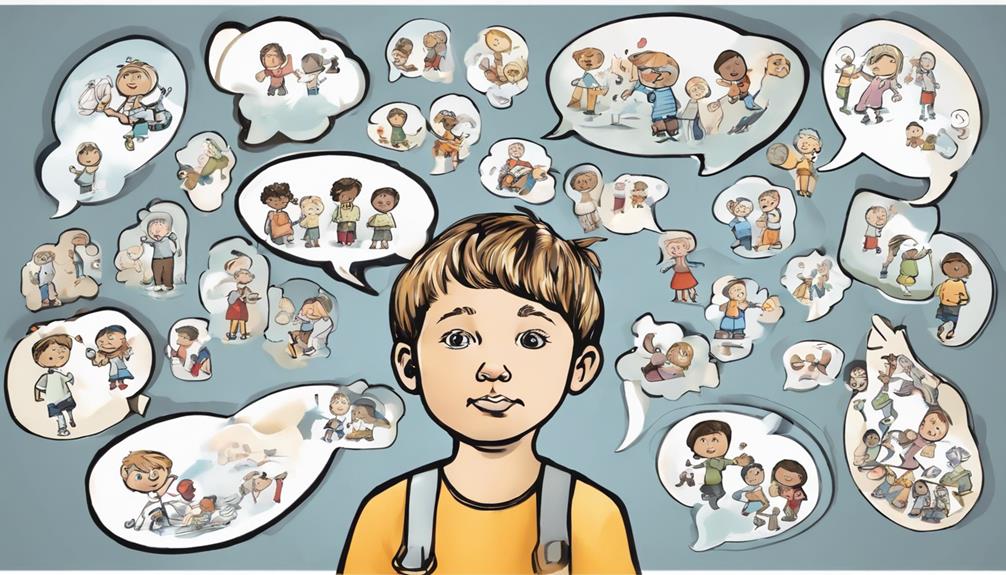
Visual aids play a crucial role in enhancing children's comprehension and response to 'Why' questions in speech therapy. By incorporating visual aids like images, illustrations, or diagrams, children can better understand and respond to the reasons behind actions or events. These visuals not only support comprehension but also enhance engagement and retention during 'Why' question activities.
Pairing visual aids with 'Why' questions can significantly improve critical thinking skills and reasoning abilities in children. When visual support is integrated into 'Why' question activities, it leads to enhanced learning outcomes for the children. The use of visuals is an effective strategy to help children grasp the context and meaning behind 'Why' questions, making the learning process more interactive and stimulating for them.
Activities for 'Why' Questions

Let's explore role-playing scenarios coupled with visual aids as effective tools to practice 'why' questions in speech therapy.
By immersing students in real-life situations, we can foster a deeper understanding of cause-and-effect relationships.
These activities aim to enhance critical thinking skills and encourage active participation in learning 'why' questions.
Role-Playing Scenarios for 'Why
Engaging in role-playing scenarios for 'Why' questions offers children a hands-on and interactive way to explore causes and reasons in real-life situations. This method fosters critical thinking and reasoning skills, prompting children to articulate motives and purposes. Through role-play, kids grasp the link between actions and consequences, enhancing their understanding of 'Why' questions.
Here are four ways role-playing scenarios benefit children:
- Encourages critical thinking by explaining motives.
- Helps understand the connection between actions and outcomes.
- Enhances communication skills through coherent responses.
- Makes learning cause and effect interactive and enjoyable.
Using Visual Aids Efficiently
When incorporating visual aids efficiently for 'Why' question activities in speech therapy, we aim to enhance understanding and engagement through interactive methods. Visual aids play a crucial role in helping children grasp cause-and-effect relationships, making learning more effective.
Activities such as story read-alouds and science experiments can be enriched by incorporating visuals, prompting children to explore and understand 'Why' questions more actively. Using picture scenes and real-life scenarios with visual support can provide a tangible way for children to connect with the content and formulate responses to 'Why' questions.
Firefly Activity

The Firefly-Themed Why Question Activity offers an engaging and hands-on approach to practicing why questions in speech therapy and special education settings.
- Students learn how to answer WH questions interactively through the firefly-themed activity.
- This activity promotes language development by incorporating a dough smash mat with strips that light up as students participate.
- By engaging in this interactive approach, students can enhance their critical thinking skills while having fun learning.
- The Firefly Activity aims to improve language skills by prompting students to answer why questions related to the firefly theme.
This creative and stimulating speech therapy activity provides a fun way for students to work on their language development while mastering the skill of answering why questions. By incorporating a hands-on element and making the learning experience enjoyable, students can progress in their speech therapy goals in a positive and engaging manner.
Digital Task Cards

Digital task cards are an excellent tool for enhancing speech therapy sessions. They provide an interactive platform to practice answering 'Why' questions effectively. These cards offer students a visually engaging way to work on critical thinking skills and language goals while keeping them actively involved.
Benefits of Digital Cards
In our practice, we've discovered the remarkable benefits that digital cards bring to enhancing students' comprehension and critical thinking skills in speech therapy sessions.
- Interactive Learning: Digital cards offer an interactive way to engage students in practicing 'why' questions.
- Visual Stimulation: They provide a visual platform that helps students work on comprehension skills effectively.
- Customization: These cards can be tailored to focus on specific areas where students struggle with 'why' questions.
- Feedback and Progress Tracking: Immediate feedback and progress tracking features help efficiently monitor student development, enhancing the learning process.
Incorporating digital cards into speech therapy sessions not only boosts student motivation but also increases participation in mastering the art of answering 'why' questions.
Effective Therapy Tool
Enhancing our therapy sessions with modern and engaging digital task cards has proven to be a valuable tool for guiding students in mastering 'Why' questions effectively. Digital task cards offer a dynamic approach to targeting WH-questions, aiding in speech therapy and language development.
These cards provide visual and interactive support, helping students practice answering 'Why' questions while improving comprehension skills. By incorporating digital task cards, students can choose from picture-supported answer choices, enhancing critical thinking abilities.
This tool not only boosts engagement and motivation but also allows for a versatile way to work on 'Why' questions during therapy sessions. Overall, digital task cards serve as an effective therapy tool for facilitating students' understanding and proficiency in answering 'Why' questions.
Causal Conjunctions Exercise
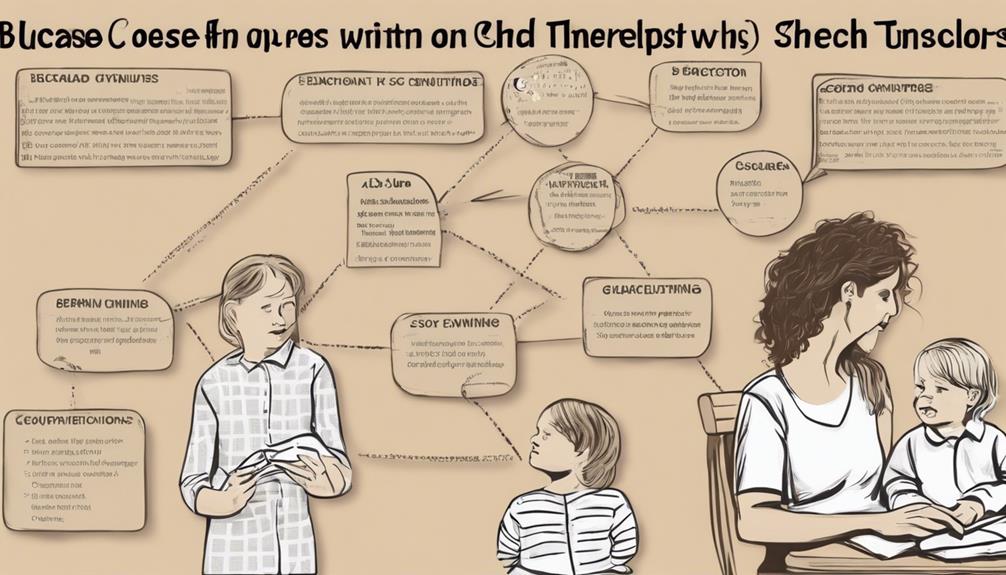
When learning to answer 'why' questions in speech therapy, mastering causal conjunctions such as 'because,' 'so,' and 'since' becomes a crucial exercise. This exercise is vital for developing complex sentence structures and reasoning skills, enhancing communication abilities through speech therapy sessions.
Here are some key points about the causal conjunctions exercise:
- Enhanced Reasoning: Practicing with causal conjunctions allows individuals to explain reasons and connections more effectively.
- Improved Communication: Mastering causal conjunctions in speech therapy enhances comprehension and communication abilities.
- Structured Learning: The exercise includes examples and multiple opportunities for learners to master answering 'why' questions.
- Skill Development: By focusing on causal conjunctions, individuals can develop the skills necessary for constructing coherent and logical responses in therapy settings.
Engaging in this exercise not only sharpens one's ability to answer 'why' questions but also lays a solid foundation for improved reasoning and communication skills in speech therapy.
Historical WH-Questions

Exploring historical WH-questions delves into the depths of past events, figures, and contexts through probing inquiry. By delving into historical context, critical thinking is fostered, leading to a deeper comprehension and analysis of significant events. These questions prompt us to consider the causes and motivations that underpin historical occurrences, encouraging a holistic understanding of history.
Answering historical WH-questions not only enriches our knowledge of the past but also hones our language skills. By engaging with these queries, students develop a nuanced understanding of the interconnectedness between past events and their present-day repercussions.
Through exploring historical WH-questions, we unravel the layers of history, piecing together the narratives that have shaped our world. This process not only broadens our historical perspective but also cultivates empathy and a more profound appreciation for the complexities of human experiences throughout time.
Main Idea Passages
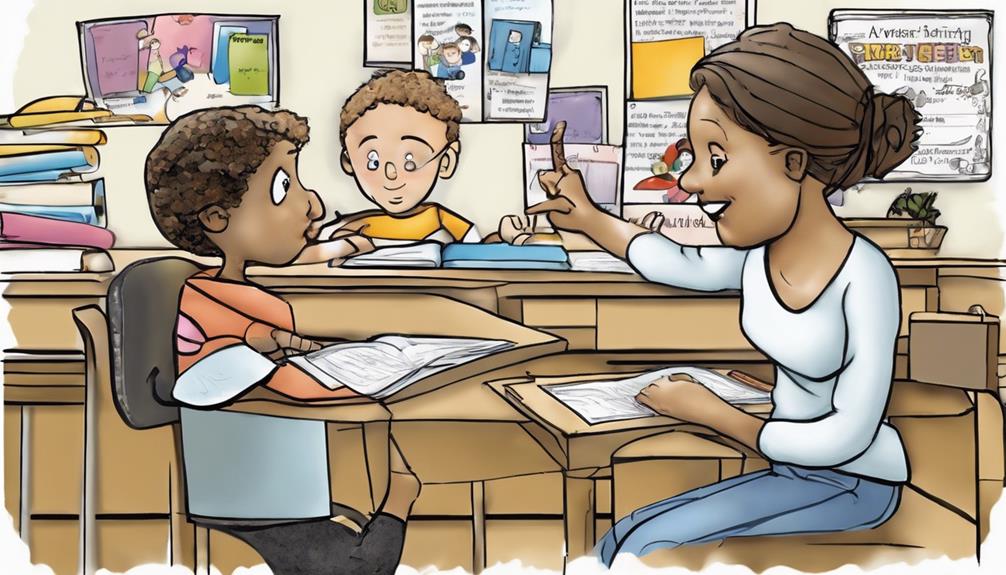
Delving into main idea passages provides a structured approach for honing our skills in answering 'why' questions during speech therapy sessions. Main idea passages are beneficial for developing critical thinking skills and enhancing comprehension in various contexts. Here are some key points to consider when working with main idea passages:
- Exploring Various Topics: Main idea passages cover a range of subjects and events, offering opportunities to delve into different contexts for answering 'why' questions effectively.
- Identifying Main Ideas: These passages help individuals in pinpointing the main idea or purpose behind the presented information, fostering critical thinking abilities necessary for addressing 'why' questions.
- Context-Rich Environment: Main idea passages create a rich learning environment that targets 'why' questions, improving reasoning skills and overall speech comprehension.
- Engagement Through Themes: Engaging with historical or travel-themed passages can make the learning process enjoyable while mastering the art of answering 'why' questions in speech therapy sessions.
Summary and Next Steps

As we wrap up our exploration of main idea passages and their role in enhancing 'why' question skills, let's now shift our focus towards summarizing our key learnings and outlining the next steps in our speech therapy journey.
Understanding the significance of 'why' questions in speech therapy is crucial for nurturing critical thinking and reasoning skills. By implementing engaging activities such as story read-alouds and science experiments, we can effectively target 'why' questions, making learning more interactive and enjoyable.
Utilizing resources like firefly-themed activities and digital task cards can further enhance comprehension of 'why' questions. It's essential to focus on answering 'why' questions using causal conjunctions to help build complex sentence structures and foster deeper understanding.
Exploring historical and travel-themed passages provides valuable opportunities to practice 'why' questions and identify main ideas, enriching speech therapy sessions. Moving forward, let's continue to learn and practice 'why' questions through engaging activities to strengthen our critical thinking skills and reasoning abilities.
Frequently Asked Questions
How Do You Answer Why Questions in Speech Therapy?
When answering 'why' questions in speech therapy, we focus on providing reasons, motives, or causes behind actions or events. This helps develop critical thinking skills and encourages understanding of relationships.
Engaging in activities like story read-alouds and science experiments can help practice 'why' questions effectively.
When Should Children Be Able to Answer Why Questions?
We believe children should typically answer 'why' questions around age 3 to 4. It's a significant language milestone indicating cognitive growth. Struggling with 'why' questions might hint at speech or language delays.
Understanding reasons behind actions is vital for development. Practicing 'why' questions can boost critical thinking and communication skills. It's essential for kids to master 'why' questions to enhance their overall language abilities and cognitive development.
How Do You Teach a Child to Ask Why Questions?
We teach children to ask 'why' questions by fostering curiosity and encouraging critical thinking skills. Real-life scenarios and open-ended discussions help them formulate meaningful 'why' questions.
Exploring cause-and-effect relationships allows them to understand the concept behind 'why' questions. Modeling asking 'why' questions demonstrates the thought process and prompts deeper conversations.
Visual aids, storybooks, and hands-on activities make learning interactive and engaging for children.
What Is the Hierarchy of Asking Questions in Speech Therapy?
In speech therapy, the hierarchy of asking questions progresses from concrete to abstract. We start with 'What' questions for younger children, then move on to 'Where' and 'Who' before tackling 'Why' and 'How'. This understanding helps tailor interventions to a child's developmental stage and language abilities.
Mastering 'Why' questions signifies advanced language skills and critical thinking. Progressing through this hierarchy is vital for enhancing cognitive abilities and communication proficiency.
Are “Why” Questions Essential in Speech Therapy?
In mastering WH questions therapy, “why” questions play a crucial role in speech therapy. They encourage critical thinking, reasoning, and problem-solving skills, vital for effective communication. Incorporating “why” questions in therapy sessions helps individuals improve their language comprehension and expression, leading to better communication abilities.
Conclusion
In conclusion, mastering 'why' questions is like unlocking a treasure chest of language development for children.
By delving into the depths of reasoning and critical thinking, we open doors to enhanced communication skills and cognitive growth.
So, let's continue to guide our little ones through the maze of 'why' questions, paving the way for brighter futures filled with curiosity and understanding.
Together, we can watch them shine like stars in the night sky of learning.
Therapies and Interventions
7 Auditory Processing Disorder Goals for Speech Therapy Success
Begin your journey to mastering the 7 Auditory Processing Disorder goals with the letter 'B' and unlock the secrets to transformative speech therapy outcomes.

As speech therapists, we all strive for optimal outcomes in our sessions, and mastering the 7 Auditory Processing Disorder goals is paramount for success. These goals serve as the cornerstone for effective communication strategies and overall improvement in auditory processing skills.
By honing in on key areas such as auditory discrimination, comprehension, and sound blending, we pave the way for significant progress in our clients' speech therapy journey.
But what lies beyond these fundamental goals? Stay tuned to uncover the intricate details that can truly make a difference in therapeutic interventions.
Key Takeaways
- Customize communication objectives for tailored interventions and progress tracking.
- Enhance sound recognition and discrimination skills for improved auditory processing.
- Develop proficient sound blending through multisensory techniques and phonemic activities.
- Strengthen language comprehension and speech production for effective communication outcomes.
Setting Clear Communication Objectives
In speech therapy for Auditory Processing Disorder (APD), setting clear communication objectives is essential to improve auditory discrimination, comprehension, and speech understanding. By establishing precise goals tailored to address individual needs, we can effectively target areas such as sound processing, auditory memory, and following multi-step directions. These measurable objectives not only help track progress but also enhance crucial auditory processing skills vital for improved communication abilities. Customizing goals to suit specific abilities ensures that interventions are focused and supportive, maximizing success in managing APD symptoms through speech therapy.
In our practice, we emphasize the importance of enhancing listening skills, speech clarity, and sound recognition to achieve functional communication outcomes. By honing in on these key areas, we aim to equip individuals with the tools necessary to navigate the challenges posed by APD. Through setting clear communication objectives, we pave the way for significant advancements in auditory discrimination, comprehension, and speech understanding, ultimately fostering success in speech therapy for Auditory Processing Disorder.
Improving Auditory Discrimination Skills

When improving auditory discrimination skills, we focus on sound recognition techniques and developing listening skills.
These skills are crucial for enhancing phonemic awareness, which is vital for reading and spelling proficiency.
Sound Recognition Techniques
Utilizing sound recognition techniques is essential for enhancing auditory discrimination skills in individuals with Auditory Processing Disorder (APD). These strategies focus on improving auditory processing skills, speech aspects, phonemes, and auditory discrimination skills.
By honing in on these areas, individuals with APD can better grasp complex utterances, engage in conversations, and follow directions effectively. Sound recognition techniques aid in differentiating between sounds, attaching meaning to them, and manipulating phonetic elements accurately.
Speech therapists play a crucial role in implementing these techniques to address auditory processing difficulties, leading to improved receptive language skills and enhanced communication abilities in individuals with APD.
Through targeted interventions, individuals can develop the necessary skills to navigate the challenges associated with APD and improve their overall quality of life.
Listening Skill Development
Enhancing auditory discrimination skills is a key component in the development of listening abilities for individuals with Auditory Processing Disorder. Auditory discrimination involves distinguishing between similar sounds like 'p' and 'b' to enhance listening comprehension, aiding in speech perception and language development.
Speech therapy targets auditory discrimination to help individuals recognize and interpret speech sounds accurately. Improved auditory discrimination skills lead to better understanding of spoken language and enhanced communication abilities.
Developing auditory discrimination is crucial for overcoming challenges in processing auditory information and following verbal instructions effectively.
- Distinguishing between similar sounds enhances listening comprehension
- Speech therapy aids in speech perception and language development
- Recognizing and interpreting speech sounds accurately is crucial
- Improved auditory discrimination skills lead to better understanding of spoken language
- Overcoming challenges in processing auditory information is essential
Enhancing Sound Blending Proficiency
How can we effectively boost sound blending proficiency in individuals undergoing auditory processing disorder (APD) therapy?
Sound blending is crucial for improving phonological awareness, language comprehension, and speech clarity. Enhancing sound blending skills involves combining individual sounds to form words or sentences accurately.
In APD therapy, sound blending exercises focus on blending sounds smoothly and rapidly. Interventions like phonemic awareness activities, repetition exercises, and multisensory techniques are effective for developing sound blending proficiency.
Strengthening Listening Comprehension Abilities

When it comes to strengthening listening comprehension abilities in individuals with Auditory Processing Disorder (APD), focusing on enhancing auditory discrimination and improving sound recognition are crucial points. These aspects play a significant role in helping individuals accurately process and understand auditory information.
Enhancing Auditory Discrimination
Improving auditory discrimination skills is essential for individuals with Auditory Processing Disorder to enhance their listening comprehension abilities. Auditory discrimination involves distinguishing speech sounds like /b/ and /d/, which is crucial for developing language skills and boosting comprehension of spoken language.
Here are five key points to consider when enhancing auditory discrimination:
- Training goals target improving the ability to differentiate subtle sound differences.
- Strengthening auditory discrimination aids in language development.
- Enhanced auditory discrimination helps in distinguishing speech sounds in noisy environments.
- Improved auditory discrimination supports accurate processing of auditory information.
- Developing auditory discrimination skills is vital for effective communication.
Improving Sound Recognition
To strengthen listening comprehension abilities in individuals with Auditory Processing Disorder, enhancing sound recognition skills through targeted speech therapy activities is crucial. Speech therapy focuses on tasks like sound discrimination and auditory memory exercises to improve sound recognition.
By honing these skills, children with Auditory Processing Disorder can better identify and understand subtle differences in speech sounds, aiding in their overall listening comprehension. Developing phonological awareness and the ability to differentiate between similar sounds are key goals in speech therapy for sound recognition.
Successful improvement in sound recognition can significantly enhance communication, academic performance, and social interactions for individuals dealing with Auditory Processing Disorder. Through tailored interventions, speech therapy plays a vital role in empowering individuals to navigate auditory processing challenges effectively.
Developing Effective Speech Production

In developing effective speech production for individuals with Auditory Processing Disorder (APD), a focus on articulation, phonological awareness, and speech clarity is essential. When working on speech production goals for individuals with APD, we aim to enhance their communication abilities through targeted interventions.
- Articulation: Target specific speech sounds and patterns to improve speech intelligibility.
- Phonological Awareness: Enhance the understanding of sounds and their relationship to language for better speech discrimination.
- Speech Clarity: Work on improving speech sound production accuracy to reduce communication breakdowns.
- Prosody and Intonation: Provide strategies to enhance speech pacing, intonation, and prosody for a natural flow of speech.
- Coordination: Strengthen the connection between auditory processing, speech production, and language comprehension to boost overall communication outcomes.
Building Vocabulary and Language Skills

Building vocabulary and language skills in individuals with Auditory Processing Disorder involves incorporating engaging multisensory activities and targeted repetition to enhance word recognition. Language development in speech therapy for APD includes phonological awareness tasks like rhyming and sound segmenting. Storytelling and narrative activities can enhance language comprehension and expression. Visual aids and real-life examples support vocabulary acquisition and language expansion in therapy sessions. Specific language goals such as sentence structure and word retrieval can improve communication abilities in children with APD.
| Multisensory Activities | Repetition |
|---|---|
| Engaging and Interactive | Targeted and Purposeful |
| Stimulates Learning | Enhances Word Recognition |
| Encourages Participation | Reinforces Vocabulary |
| Boosts Language Skills | Strengthens Memory |
Implementing Multisensory Learning Techniques

Enhancing therapy outcomes for individuals with Auditory Processing Disorder involves incorporating multisensory learning techniques that engage multiple senses to optimize information processing. By integrating various sensory modalities such as auditory, visual, tactile, and kinesthetic stimuli, speech therapists can create a more holistic approach to address the unique needs of those with APD.
- Multisensory learning techniques engage multiple senses like hearing, touch, and sight to enhance information processing in individuals with Auditory Processing Disorder (APD).
- These techniques involve combining auditory input with visual, tactile, or kinesthetic stimuli to reinforce learning and memory retention for individuals with APD.
- Implementing multisensory strategies in speech therapy can improve auditory discrimination, sound recognition, and language processing skills in individuals with APD.
- By incorporating multisensory approaches, speech therapists can address the unique sensory needs and preferences of individuals with APD to optimize therapy outcomes.
- Multisensory learning helps individuals with APD strengthen neural connections, enhance sensory integration, and improve overall communication abilities through varied sensory experiences.
Frequently Asked Questions
How to Treat Auditory Processing Disorder in Speech Therapy?
In speech therapy, we treat Auditory Processing Disorder by focusing on improving auditory discrimination, comprehension, and memory skills. Our strategies include using visual aids, repetition techniques, and chunking information for better understanding and retention.
We collaborate with audiologists and educators to tailor a comprehensive treatment plan to individual needs. Our therapy goals involve enhancing phonological awareness, speech articulation, and language processing to address the challenges of APD and improve overall communication skills.
What Are the Goals for Auditory Discrimination in Speech Therapy?
When aiming for auditory discrimination in speech therapy, we strive to enhance the ability to distinguish similar sounds like /b/ and /p/.
This focus on recognizing subtle differences in speech sounds improves language skills. Through activities like minimal pair exercises, we work on refining the ability to differentiate sounds, leading to clearer speech and more effective communication.
Success in these goals can greatly enhance overall speech clarity and language proficiency.
Can You Be Successful With Auditory Processing Disorder?
Yes, success is achievable with Auditory Processing Disorder (APD) through tailored therapy strategies and interventions.
With proper support and understanding, individuals can thrive despite their unique auditory processing challenges.
Collaborating with a multidisciplinary team and consistent therapy can lead to positive outcomes for those managing APD.
Do SLPs Work With Auditory Processing Disorder?
Yes, we work with individuals with Auditory Processing Disorder. Our role as speech-language pathologists involves assessing and addressing auditory processing difficulties that affect speech and language development.
By collaborating with audiologists and using evidence-based strategies, we help individuals enhance their auditory processing, speech production, and language comprehension skills.
Our goal is to provide support and therapy to improve their ability to process and interpret auditory information effectively.
Conclusion
In conclusion, by focusing on these 7 auditory processing disorder goals in speech therapy, we can pave the way for successful communication outcomes.
It's like hitting the bullseye with a slingshot – precise, effective, and rewarding.
Let's continue to collaborate, adapt, and empower individuals with auditory processing difficulties to unlock their full potential in communication and language skills.
Together, we can make a significant impact on their journey towards improved auditory processing abilities.
Jamie is one of the creative forces behind the words that resonate with our audience at Deaf Vibes. With a passion for storytelling and advocacy, Jamie delves into topics that matter deeply to the deaf and hard-of-hearing community. Jamie’s articles are crafted with empathy, insight, and a commitment to positive change, from exploring the latest advancements in hearing technologies to shedding light on the everyday challenges and victories of those within the community. Jamie believes in the power of shared stories to inspire action, foster understanding, and create a more inclusive world for everyone.
Therapies and Interventions
Effective Auditory Verbal Therapy Lesson Plans for Learning Success
Step into the world of Auditory Verbal Therapy where structured lesson plans hold the key to unlocking learning success for children with hearing loss.

As we reflect on the impact of well-crafted Auditory Verbal Therapy lesson plans, we recognize the significance of structuring sessions to optimize learning outcomes. Beginning with clear objectives tailored to each child's unique needs ensures a solid foundation for progress.
However, the question arises: how can we effectively implement these strategies to enhance auditory skills and foster learning success in children with hearing loss? Let's explore practical approaches and key considerations that can drive meaningful advancements in therapy sessions and ultimately contribute to overall educational achievements.
Key Takeaways
- Tailoring individualized plans optimizes progress and skill development.
- Targeted activities enhance auditory, speech, and language goals effectively.
- Strategies focus on improving auditory skills and language comprehension.
- Personalized approaches ensure engagement, motivation, and tailored learning outcomes.
Importance of Lesson Planning
Lesson planning is crucial in Auditory Verbal Therapy as it ensures a structured and effective approach to therapy sessions for children with hearing loss. By meticulously planning each session, we maximize learning opportunities for our young learners, enabling us to track progress and adjust strategies as needed.
Through well-crafted lesson plans, we establish clear objectives that align with the child's speech and language development goals, fostering the acquisition of essential auditory skills. Moreover, these plans facilitate therapist-parent collaboration, encouraging consistent practice at home to reinforce communication skills outside of therapy sessions.
Our tailored activities target various auditory-verbal skills, promoting comprehensive language acquisition and auditory skill development. With a thoughtfully designed lesson plan, we create a conducive environment for smooth session flow, engagement, and ultimately, the advancement of our children with hearing loss towards their communication goals.
Tailoring Plans to Individual Needs

As we tailor auditory-verbal therapy plans to individual needs, our focus shifts towards assessing the child's current auditory and language skills to guide targeted development effectively. When creating personalized plans for children, we consider various aspects to ensure the therapy is tailored to their specific requirements. This approach allows us to address their unique strengths and challenges, maximizing progress and engagement throughout the learning process.
Here are some key factors we take into account:
- Auditory Discrimination: Assessing the child's ability to distinguish between different sounds.
- Language Comprehension: Evaluating how well the child understands spoken language.
- Speech Production: Targeting areas for improvement in producing clear and intelligible speech.
- Hearing Technology: Considering the use of devices like hearing aids or cochlear implants.
- Communication Goals: Establishing objectives for enhancing overall communication skills.
Incorporating Targeted Activities
Incorporating targeted activities in auditory-verbal therapy involves designing tailored exercises to address specific auditory, speech, language, and cognitive goals in each session. These activities aim to enhance listening skills, auditory feedback, language development, speech sounds, auditory processing, language skills, and phonological awareness. By incorporating interactive games and structured exercises such as sound matching, syllable segmentation, and phoneme blending, therapists can create engaging experiences that strengthen these skills. It's crucial to align these activities with individualized learning objectives to ensure maximum effectiveness in auditory verbal therapy sessions.
Using a variety of activities that encourage active listening and sound discrimination, therapists can help children with hearing loss improve their auditory processing and language comprehension. By providing multi-sensory experiences, therapists can create a dynamic learning environment that supports holistic development. These targeted activities not only make therapy sessions more engaging but also play a vital role in achieving positive outcomes in auditory-verbal therapy.
Strategies for Enhancing Auditory Skills
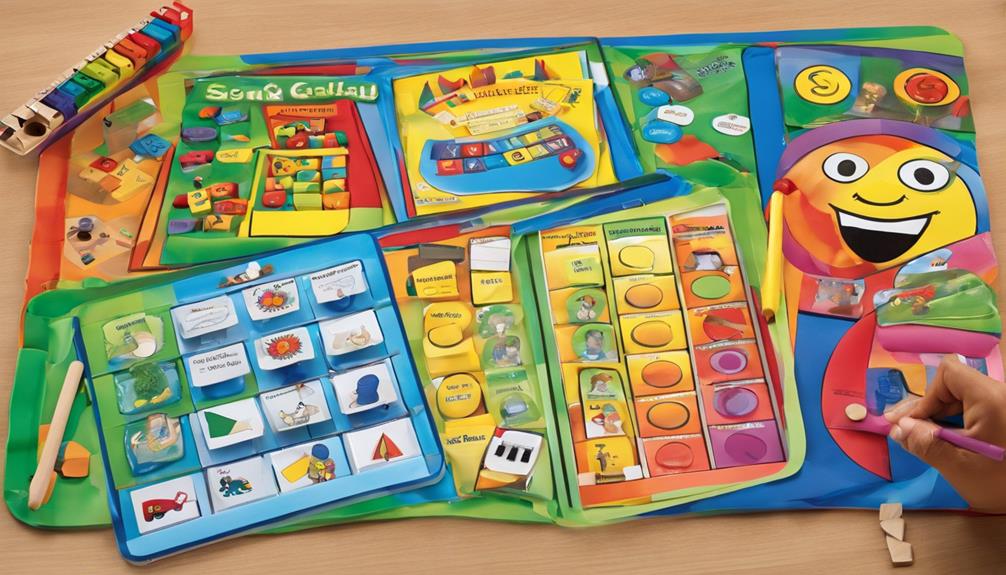
Enhancing auditory skills is fundamental in fostering language development and communication abilities in children with hearing loss. Implementing strategies to enhance auditory skills can significantly impact cognitive development and language skills. Here are some evidence-based strategies for enhancing auditory skills in children with hearing loss:
- Engage in auditory identification activities to aid vocabulary development and language skills.
- Focus on phonological awareness at the syllable and phoneme level to improve oral and written language mastery.
- Utilize auditory-verbal techniques such as speech babble and word manipulation exercises to boost phonological awareness skills effectively.
- Incorporate targeted interventions and structured activities to enhance auditory awareness and discrimination for improved language comprehension.
- Implement sound sorting activities to enhance auditory skills and support vocabulary development.
Personalization for Learning Success
For optimal learning outcomes in auditory verbal therapy, tailoring intervention plans to the unique needs and abilities of each child with hearing loss is essential. Personalization plays a crucial role in creating individualized lesson plans that consider a child's auditory, speech, language, and cognitive skills.
By customizing activities and techniques to cater to the child's specific goals and learning style, personalized therapy sessions enhance engagement, motivation, and progress in developing spoken language skills. This tailored approach fosters a supportive and effective learning environment, maximizing the child's potential for successful auditory-verbal skill development.
Through the implementation of personalized intervention plans, the child receives targeted support that addresses their unique requirements, ultimately leading to optimal learning outcomes in auditory verbal therapy. By focusing on personalization, we can ensure that each child's journey towards enhancing their auditory skills is tailored to their individual needs and abilities, promoting a more effective and engaging learning experience.
Frequently Asked Questions
What Is the Strategy of Auditory-Verbal Therapy?
We believe the strategy of auditory-verbal therapy revolves around harnessing residual hearing to develop spoken language skills in children with hearing loss. This therapy focuses on teaching children to listen and speak effectively, aiming for independence in communication.
What Is the Efficacy of Auditory-Verbal Therapy?
The efficacy of Auditory-Verbal Therapy (AVT) is well-documented, showing significant improvements in speech and language skills for children with hearing loss. Through a family-centered approach, AVT helps children integrate successfully into mainstream schools, fostering positive social and emotional outcomes.
Early intervention with AVT is critical for enhancing speech, social development, and interaction in children with hearing loss. AVT empowers individuals, promotes independence, and tailors therapy to individual needs, ensuring optimal outcomes.
What Are the Goals of Avt?
The goals of AVT include developing spoken language skills in children with hearing loss. AVT aims to utilize residual hearing for speech and language abilities to help children become independent communicators. It focuses on achieving age-appropriate listening and spoken language skills through individualized intervention plans.
Early detection and intervention are emphasized for optimal language development, utilizing sound for speech, social, and interactional growth. AVT benefits children by improving speech and language skills, facilitating integration into mainstream schools, and enhancing social and emotional outcomes.
What Are the Principles of Avt?
The principles of AVT emphasize developing spoken language skills in children with hearing loss by utilizing residual hearing for communication. AVT focuses on early intervention, family-centered approaches, individualized plans, and the belief that all children can learn to listen and speak.
It empowers individuals, strengthens family involvement, and tailors therapy to individual needs for optimal outcomes in integrating into mainstream schools and enhancing social and emotional development.
Conclusion
In the symphony of auditory verbal therapy, our lesson plans serve as the conductor, guiding each child towards the crescendo of learning success.
Just as each note plays a crucial role in creating a harmonious melody, our tailored activities and strategies work together to unlock the potential within each child with hearing loss.
Through personalized and engaging sessions, we aim to cultivate the seeds of language, communication, and overall learning growth, leading to a beautiful and fulfilling journey ahead.
Jamie is one of the creative forces behind the words that resonate with our audience at Deaf Vibes. With a passion for storytelling and advocacy, Jamie delves into topics that matter deeply to the deaf and hard-of-hearing community. Jamie’s articles are crafted with empathy, insight, and a commitment to positive change, from exploring the latest advancements in hearing technologies to shedding light on the everyday challenges and victories of those within the community. Jamie believes in the power of shared stories to inspire action, foster understanding, and create a more inclusive world for everyone.
Therapies and Interventions
7 Ways Avatar Therapy Transforms Auditory Hallucinations
Journey into a world where voices come to life, as Avatar Therapy revolutionizes the treatment of auditory hallucinations in seven unique ways.
Imagine stepping into a world where voices become visible entities, where the intangible becomes tangible. Avatar Therapy, with its innovative approach to auditory hallucinations, unveils a realm of possibilities that redefine conventional methods of treatment.
From enhancing patient-therapist interactions to fostering self-compassion and identity, this therapy opens doors to a transformative journey towards reclaiming one's sense of self.
Join us as we explore the profound impact of Avatar Therapy on individuals grappling with auditory hallucinations, unlocking seven key ways this approach revolutionizes their experience.
Key Takeaways
- Customized avatars mirror hallucination characteristics, enhancing therapeutic dialogue.
- Encourages active engagement to confront and manage distressing voices effectively.
- Fosters empowerment through challenging voices, building self-confidence, and control.
- Supports internal locus by addressing origins of hallucinations, promoting self-reflection, and personalized coping strategies.
Enhancing Patient-Therapist Interactions
Enhancing patient-therapist interactions in avatar therapy involves leveraging the digital representation of auditory hallucinations to facilitate constructive dialogue and empowerment for individuals experiencing distressing voices. In clinical settings, participants engaging in AVATAR therapy delivery find a unique opportunity to directly confront their voices through an interactive and visual medium. By creating a tangible representation of their hallucinations, patients gain a sense of agency and control over their experiences, enabling them to challenge and manage their distressing voices effectively.
Through collaborative efforts with therapists, individuals can customize their avatars to mirror the characteristics of their auditory hallucinations, fostering a personalized approach to therapy. This collaborative process not only enhances the therapeutic bond between patients and therapists but also empowers patients to address their hallucinations with increased assertiveness and confidence. By actively engaging with their avatars, participants navigate a journey towards gaining mastery over their voices, transforming their relationship with auditory hallucinations into one of empowerment and self-control.
Encouraging Active Engagement in Therapy

Encouraging patients to actively confront their auditory hallucination avatars fosters empowerment and autonomy in therapy sessions. Through active engagement in Avatar Therapy, individuals are prompted to challenge the avatars representing their distressing voices, gradually reclaiming power and control over their auditory hallucinations. This process involves face-to-face dialogues with the avatars, aiming to shift the patients' perception of their hallucinations. By actively participating in therapy sessions, patients can develop assertiveness and autonomy in managing their auditory hallucinations. This active involvement enables individuals to work towards reducing the frequency and distress caused by the voices they hear.
| Active Engagement | Avatar Therapy | Patients |
|---|---|---|
| Power and Control | Distressing Voices | Face-to-Face Dialogue |
| Perception Shift | Assertiveness | Autonomy |
Fostering a Sense of Empowerment
In avatar therapy, individuals are empowered to challenge their distressing voices, fostering a sense of control and agency. Through interactions with their avatar, patients build self-confidence, encouraging self-expression and autonomy.
This empowerment enables individuals to make choices and assert themselves against the persecutory voices, ultimately developing strategies to cope with auditory hallucinations.
Building Self-Confidence Through Avatars
Through avatar therapy, individuals are empowered to confront and challenge their persecutory voices, gradually building self-confidence and a sense of control over distressing auditory hallucinations. Engaging with a digital representation allows patients to develop assertiveness and resilience, fostering a profound sense of empowerment.
By interacting with the avatar, individuals can reshape their perception of the voices, leading to increased self-esteem and autonomy. Building self-confidence in therapy sessions with avatars contributes significantly to reducing the distress and impact of auditory hallucinations on individuals' lives.
This process enables patients to feel more empowered in their ability to manage and cope with the challenges posed by their auditory hallucinations, promoting a greater sense of well-being and control.
Encouraging Self-Expression and Agency
Fostering a deep sense of empowerment, avatar therapy enables individuals to actively confront and challenge distressing auditory hallucinations by promoting assertive self-expression and autonomy. Through this therapy, patients are encouraged to take control and assert their agency in sessions, allowing them to stand up to the persecutory voices they hear. The dynamic shifts, granting individuals the power to engage with their hallucinations actively. By fostering self-expression and autonomy, avatar therapy cultivates a greater sense of empowerment in managing auditory hallucinations. Patients often experience increased feelings of control and empowerment post-therapy, leading to a decrease in distress caused by the auditory hallucinations.
| Benefits of Encouraging Self-Expression and Agency |
|---|
| Promotes assertive self-expression |
| Fosters a sense of empowerment |
| Enables active confrontation of auditory hallucinations |
Empowering Choice and Autonomy
Empowering individuals to actively choose and assert control over their interactions with digital avatars in avatar therapy cultivates a profound sense of empowerment in managing distressing auditory hallucinations.
By offering patients the autonomy to confront their auditory hallucinations through the digital avatar, they're presented with a unique challenge that encourages active engagement.
This process not only empowers individuals to make choices in their therapy but also instills a sense of agency in addressing their hallucinations.
Through the therapeutic experience of standing up to the avatar voice, patients can reduce the impact of their auditory hallucinations and regain a feeling of control.
Ultimately, fostering a sense of empowerment and choice in avatar therapy can significantly transform how individuals navigate and manage their auditory hallucinations.
Facilitating Personalized Symptom Management

In personalized symptom management, individuals are guided to confront and challenge distressing auditory hallucinations through interactive dialogue with tailored avatars. Avatar therapy offers a unique approach to addressing auditory hallucinations by providing visual representations that empower patients to directly engage with their symptoms. By fostering personalized interactions with these avatars, patients can develop effective strategies to cope with and reduce the impact of their hallucinations.
Key Aspects of Personalized Symptom Management:
- Visual Representation: Avatars create personalized visual representations of auditory hallucinations.
- Interactive Dialogue: Patients engage in interactive dialogues with avatars to challenge negative beliefs.
- Symptom Improvement: Through tailored sessions, individuals experience symptom improvement.
- Coping Strategies: Patients develop coping strategies to deal with distress caused by hallucinations.
- Empowerment: Avatar therapy empowers individuals to take control and reduce the impact of auditory hallucinations on their daily lives.
Promoting Self-Compassion and Self-Esteem
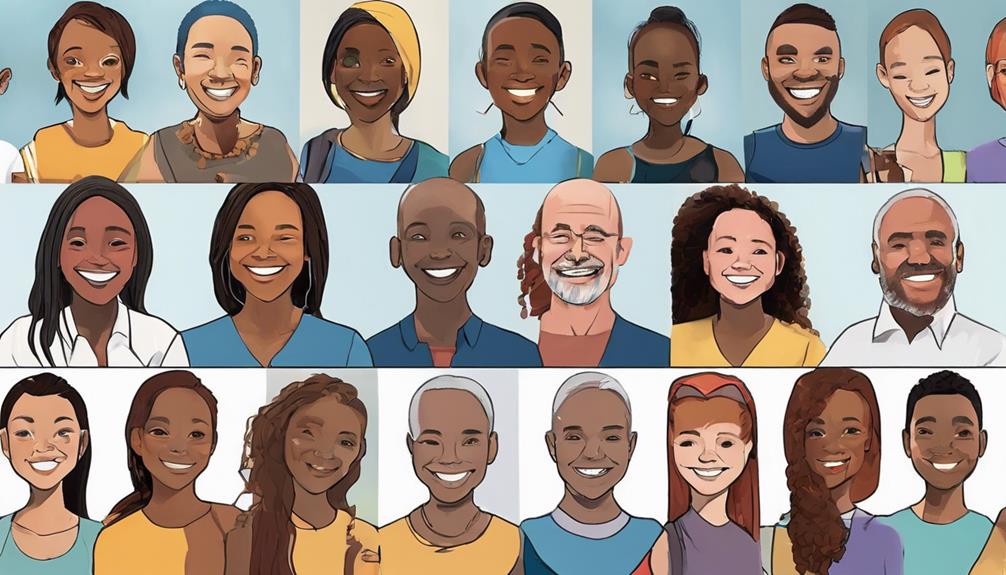
Building self-compassion and self-esteem is a fundamental aspect of avatar therapy, enabling individuals to challenge negative beliefs and enhance their self-perception amidst auditory hallucinations.
Through assertiveness and gaining control over their interactions with the avatar embodying their distressing voices, patients learn to cultivate self-esteem. By addressing the underlying issues contributing to low self-esteem and engaging in dialogue with the avatar, individuals work towards fostering self-compassion and self-respect.
This process empowers patients to shift their self-perception positively, leading to increased self-esteem and a sense of empowerment in managing auditory hallucinations. Avatar therapy provides a platform for individuals to develop a more positive self-image, promoting feelings of self-worth and confidence.
Cultivating Internal Attribution and Identity

In our exploration of avatar therapy's impact on cultivating internal attribution and identity, we find that the therapy plays a crucial role in enhancing self-awareness and strengthening individuals' internal locus of control.
By challenging negative beliefs and encouraging patients to redefine their self-perception in relation to their auditory hallucinations, avatar therapy empowers individuals to take charge of their experiences and assert control over their mental well-being.
This process of internal attribution work fosters transformative shifts in self-concept, promoting a more positive and adaptive approach to coping with auditory hallucinations.
Enhancing Self-Awareness and Identity
Encouraging individuals to delve into their past experiences and emotions fosters a deeper understanding of the triggers behind their auditory hallucinations in avatar therapy. By exploring internal attributions, patients can unravel the origins of their distressing voices, enhancing self-awareness and identity development.
Avatar therapy guides individuals in reshaping their self-perception and building self-esteem, empowering them to confront and redefine their narrative. This transformative process enables a shift towards a more positive self-concept, aiding in combating the negative impact of auditory hallucinations on personal identity.
Through introspection and self-discovery, individuals can establish a stronger sense of self-awareness and cultivate resilience in the face of challenging auditory experiences.
- Understanding past experiences and emotions
- Exploring internal attributions and triggers
- Shaping self-perception and identity
- Building self-esteem and self-respect
- Empowering individuals to redefine their narrative
Strengthening Internal Locus
Strengthening the internal locus through avatar therapy involves cultivating internal attribution and identity, empowering individuals to gain insight into the origins of their auditory hallucinations. By exploring their self-perception and identity within the therapy, patients can develop a deeper understanding of the voices they hear. Addressing internal attributions allows individuals to challenge negative beliefs, taking control of their experiences.
Avatar therapy guides patients towards focusing inward, fostering self-reflection and autonomy in managing auditory hallucinations. Cultivating internal attribution and identity in this therapy contributes significantly to reducing distress and enhancing self-esteem in those experiencing auditory hallucinations. This process not only aids in understanding the self better but also provides a pathway towards empowerment and a more positive self-concept.
Supporting Long-Term Recovery and Well-Being

To promote long-term recovery and well-being, avatar therapy equips individuals with effective coping strategies to challenge and reduce the distress caused by auditory hallucinations. Through personalized interventions and ongoing support, this therapy plays a crucial role in supporting individuals in their journey towards recovery.
Here are five ways avatar therapy supports long-term recovery and well-being:
- Empowering Individuals: Avatar therapy empowers individuals to take control of their auditory hallucinations by providing them with tools to challenge and manage distressing voices effectively.
- Enhancing Self-Esteem and Autonomy: By addressing negative beliefs and promoting assertiveness, avatar therapy helps individuals enhance their self-esteem and autonomy, leading to sustained well-being.
- Developing Coping Strategies: The therapy assists individuals in developing personalized coping strategies to manage persistent auditory hallucinations, contributing to their long-term recovery.
- Promoting Control Over Distressing Voices: Avatar therapy aims to give individuals greater control over their distressing voices, enabling them to navigate their experiences more effectively.
- Providing Ongoing Support: Through continuous support, avatar therapy ensures that individuals have the assistance they need to maintain their recovery and improve their quality of life.
Frequently Asked Questions
What Is the Avatar Therapy for Auditory Hallucinations?
Avatar therapy for auditory hallucinations involves creating a digital representation of the voice a patient hears. Therapists control the avatar to empower patients to confront and challenge the distressing voice.
The therapy typically consists of structured face-to-face sessions where patients engage with the avatar over several weeks. Avatar therapy aims to reduce the frequency and distress caused by auditory hallucinations.
Research has shown significant reductions in voice frequency and distress with the use of avatar therapy.
What Is the Best Therapy for Auditory Hallucinations?
We believe the best therapy for auditory hallucinations should focus on empowering individuals to challenge and engage with the voices they hear. By promoting autonomy, self-esteem, and challenging negative beliefs, therapy can effectively help manage distressing voices.
Therapists play a vital role in guiding patients through the process, which includes exposure, assertiveness, power, control, and autonomy phases. This approach can lead to significant reductions in auditory hallucination frequency and distress, offering promising treatment outcomes.
What Strategies Help With Auditory Hallucinations?
When dealing with auditory hallucinations, various strategies can provide relief. Techniques such as cognitive-behavioral therapy, mindfulness practices, and social support can help manage distressing voices.
Engaging in activities that promote self-esteem, challenging negative beliefs, and fostering autonomy can empower individuals to confront and assert themselves against persecutory voices. By gradually increasing control over these hallucinations, patients can learn to shift their perceptions and reduce the distress caused by auditory experiences.
How Do You Get Rid of Auditory Hallucinations Naturally?
We find that engaging in physical exercise, practicing mindfulness techniques, ensuring quality sleep, managing stress, and maintaining a balanced diet rich in nutrients can help reduce auditory hallucinations naturally.
Seeking support from mental health professionals for therapy and counseling, along with cognitive behavioral techniques, can also aid in managing these experiences.
It's important to address auditory hallucinations holistically, considering both lifestyle factors and therapeutic interventions to support overall well-being.
Conclusion
In conclusion, avatar therapy acts as a powerful tool in transforming auditory hallucinations by enhancing patient-therapist interactions, fostering empowerment, and promoting personalized symptom management.
This innovative approach cultivates self-compassion, self-esteem, and internal attribution, leading to long-term recovery and well-being.
The alliteration of these elements adds a layer of sophistication to the therapeutic process, showcasing its potential for revolutionizing mental health care.
Jamie is one of the creative forces behind the words that resonate with our audience at Deaf Vibes. With a passion for storytelling and advocacy, Jamie delves into topics that matter deeply to the deaf and hard-of-hearing community. Jamie’s articles are crafted with empathy, insight, and a commitment to positive change, from exploring the latest advancements in hearing technologies to shedding light on the everyday challenges and victories of those within the community. Jamie believes in the power of shared stories to inspire action, foster understanding, and create a more inclusive world for everyone.
-

 Navigating the VA System2 months ago
Navigating the VA System2 months agoVA Hearing Loss Rating Chart: Understanding Disability Compensation
-

 Therapies and Interventions4 weeks ago
Therapies and Interventions4 weeks ago10 Auditory Processing Goals for Effective Speech Therapy
-

 Living with Hearing Loss3 months ago
Living with Hearing Loss3 months ago10 Deaf-Friendly Dating Sites to Find Your Perfect Match
-

 Sign Language4 weeks ago
Sign Language4 weeks agoSign Language Emoji Translator: How to Communicate With Gestures
-

 Navigating the VA System2 months ago
Navigating the VA System2 months agoUnderstanding Bilateral Hearing Loss VA Rating Criteria
-

 Tinnitus2 months ago
Tinnitus2 months agoVA's Rating System for Tinnitus and Hearing Loss Explained
-

 Living with Hearing Loss3 months ago
Living with Hearing Loss3 months agoAn Introduction to Deaf Culture: Understanding the Basics
-

 Hearing Aids2 months ago
Hearing Aids2 months agoAudibel Hearing Aids Cost: A Comprehensive Guide
































